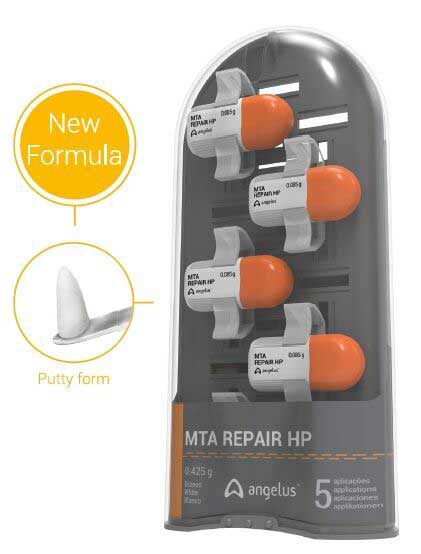 A new MTA formula that’s simple to mix and easy to manipulate and insert into the dental cavity
A new MTA formula that’s simple to mix and easy to manipulate and insert into the dental cavity
Joshua Solomon, DDS, knows that mineral trioxide aggregate (MTA) can be difficult to handle and manipulate, which sometimes leads to lengthy dental procedures. As a pediatric dentist, he also knows that children (and some adults) only cooperate for a certain amount of time, so quick dental procedures are of utmost importance.
What if someone developed a new MTA formula that guarantees the same treatment success but changes its physical properties so it is easier to work with and speeds up procedures? Angelus sought to do just that with its new MTA Repair HP, a bioceramic putty-form reparative cement. The HP stands for “high plasticity,” and this new formula maintains all the chemical and biological properties of the original MTA but changes its physical properties. The result is a product with greater plasticity, making it easier to manipulate and insert the material into the dental cavity, according to Angelus.
Dr. Solomon, along with several other dentists, tried MTA Repair HP for several weeks in their practices as part of this DPS evaluation, and we were eager to learn whether the product held to its promise.
Mixing and HandlingMTA Repair HP is “much easier to mix and prepare” and “much easier to work with than traditional MTA,” Sean Grady, DDS, said after testing the bioceramic reparative cement. One package of the powder (.085 g) is mixed with 2 drops of the liquid for 40 seconds until the ingredients are completely homogenized into a putty-like cement with high plasticity. Dr. William Lieberman noted he appreciated the premeasured portions and the easy mix.
Calling it easy to handle and to carry and place, pediatric dentist Dr. Timothy Fagan noted that there was enough material to just cover the pulp chamber floor/ pulp stumps while doing pulpotomies in primary molars. Dr. Solomon was impressed with the consistency of MTA Repair HP and said, “The putty-like consistency helped with ease of packing.” Dr. Alan Howard described it as easy to place, and Dr. Vickie Sullivan said she was very happy with the product placement and consistency but recommended more material in each capsule. Describing the material as “a little bit tacky,” Dr. Grace Chu, an endodontist, said MTA Repair HP was critical for “resorptive defect repair, especially when it is coronally positioned.”
Overall Ease of Use and Procedure TimeMTA pulpotomies are the new standard of care, according to pediatric dentist Dr. Lieberman, and he found that MTA Repair HP allowed him to complete procedures faster and saved chair time. Time savings is particularly critical, Dr. Lieberman said, when dealing with difficult pediatric patients who often have short attention spans. Dr. Henry Phillips agreed that this material saves time and is easy to use, and Dr. Solomon also said his procedures went more quickly. “In pediatric patients, there is a limited time for cooperation,” Dr. Solomon explained, “and the ease of mixing and putty-like consistency increased the speed of the MTA pulpotomy.”
Dr. Daniel Florian praised the MTA Repair HP for its versatility, and Dr. Lieberman would like to see “an instrument designed to transfer the mixed material.” Dr. Grady described a case where his patient had a lower molar with a very calcified mesiobuccal canal. “I had to search and search, and after doing so, I perforated the furcation slightly,” Dr. Grady explained. “This product was ideal to repair this perforation, and I’m confident it will increase the long-term prognosis of the restoration.”

According to Angelus, MTA Repair HP solidifies when kept in a wet environment after spatulation, and the initial setting time is approximately 15 minutes. “The quick set time was extremely helpful,” shared Dr. Sullivan, who said the product was a great improvement over regular MTA. Dr. Chu said the material sealed well and set completely when her patient returned for the final restoration of the access opening.
Regarding esthetics, Dr. Chu said the color was great for more coronal repairs. Angelus added a radiopacifier (CaWO4) to the formula to avoid staining of the root or dental crown, and Dr. Sullivan pointed out that it was too soon to see if it will discolor under fillings. Dr. Sullivan told DPS about a case where MTA Repair HP greatly enhanced a direct pulp capping on an open apex 6-year molar. She predicted, “That could mean more successful outcomes and less need for root canal treatment in the future.”
Dr. Fagan pointed out that scientific studies show that it’s an excellent material for pulpotomies, and Dr. Florian enjoyed that MTA Repair HP “gives me a second chance at saving a tooth.”
Overall Satisfaction“I am very happy to see a manufacturer has developed an endodontic repair material that is easy to prepare and dispense compared to MTA, which historically has been much more difficult,” shared Dr. Grady. “Once people use this I can’t imagine them going back to [traditional] MTA,” he added. Rating his overall satisfaction as excellent, endodontist Dr. Nathaniel Behrents concluded, “[MTA Repair HP is] an effective biocompatible material.”







